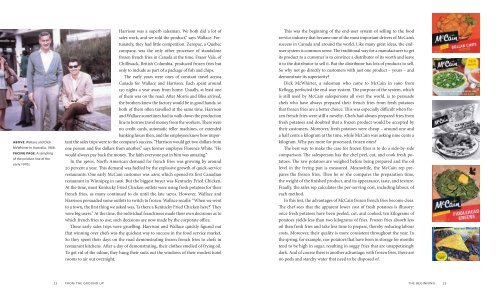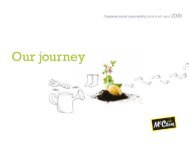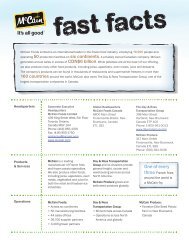From the Ground Up - McCain Foods Limited
From the Ground Up - McCain Foods Limited
From the Ground Up - McCain Foods Limited
You also want an ePaper? Increase the reach of your titles
YUMPU automatically turns print PDFs into web optimized ePapers that Google loves.
ABOVE: Wallace and Dick<br />
McWhirter in Australia, 1968.<br />
FACING PAGE: A sampling<br />
of <strong>the</strong> product line of <strong>the</strong><br />
early 1970s.<br />
Harrison was a superb salesman. We both did a lot of<br />
sales work, and we sold <strong>the</strong> product,” says Wallace. Fortunately,<br />
<strong>the</strong>y had little competition. Zeropac, a Quebec<br />
company, was <strong>the</strong> only o<strong>the</strong>r processor of standalone<br />
frozen french fries in Canada at <strong>the</strong> time. Fraser Vale, of<br />
Chilliwack, British Columbia, produced frozen fries but<br />
only to include as part of a package of fish and chips.<br />
The early years were ones of constant travel across<br />
Canada for Wallace and Harrison. Each spent around<br />
150 nights a year away from home. Usually, at least one<br />
of <strong>the</strong>m was on <strong>the</strong> road. After Morris and Bliss arrived,<br />
<strong>the</strong> bro<strong>the</strong>rs knew <strong>the</strong> factory would be in good hands, so<br />
both of <strong>the</strong>m often travelled at <strong>the</strong> same time. Harrison<br />
and Wallace sometimes had to walk down <strong>the</strong> production<br />
line to borrow travel money from <strong>the</strong> workers. There were<br />
no credit cards, automatic teller machines, or extended<br />
banking hours <strong>the</strong>n, and <strong>the</strong> employees knew how important<br />
<strong>the</strong> sales trips were to <strong>the</strong> company’s success. “Harrison would get two dollars from<br />
one person and five dollars from ano<strong>the</strong>r,” says former employee Florence White. “He<br />
would always pay back <strong>the</strong> money. The faith everyone put in him was amazing.”<br />
In <strong>the</strong> 1960s, North American demand for french fries was growing by around<br />
20 percent a year. This demand was fuelled by <strong>the</strong> explosive growth of quick-service<br />
restaurants. One early <strong>McCain</strong> customer was A&W, which opened its first Canadian<br />
restaurant in Winnipeg in 1956. But <strong>the</strong> biggest buyer was Kentucky Fried Chicken.<br />
At <strong>the</strong> time, most Kentucky Fried Chicken outlets were using fresh potatoes for <strong>the</strong>ir<br />
french fries, as many continued to do until <strong>the</strong> late 1970s. However, Wallace and<br />
Harrison persuaded some outlets to switch to frozen. Wallace recalls: “When we went<br />
to a town, <strong>the</strong> first thing we asked was, ‘Is <strong>the</strong>re a Kentucky Fried Chicken here?’ They<br />
were big users.” At <strong>the</strong> time, <strong>the</strong> individual franchisees made <strong>the</strong>ir own decisions as to<br />
which french fries to use; such decisions are now made by <strong>the</strong> corporate office.<br />
These early sales trips were gruelling. Harrison and Wallace quickly figured out<br />
that winning over chefs was <strong>the</strong> quickest way to success in <strong>the</strong> food service market.<br />
So <strong>the</strong>y spent <strong>the</strong>ir days on <strong>the</strong> road demonstrating frozen french fries to chefs in<br />
restaurant kitchens. After a day of demonstrating, <strong>the</strong>ir clo<strong>the</strong>s smelled of frying oil.<br />
To get rid of <strong>the</strong> odour, <strong>the</strong>y hung <strong>the</strong>ir suits out <strong>the</strong> windows of <strong>the</strong>ir modest hotel<br />
rooms to air out overnight.<br />
This was <strong>the</strong> beginning of <strong>the</strong> end-user system of selling to <strong>the</strong> food<br />
service industry that became one of <strong>the</strong> most important drivers of <strong>McCain</strong>’s<br />
success in Canada and around <strong>the</strong> world. Like many great ideas, <strong>the</strong> enduser<br />
system is common sense. The traditional way for a manufacturer to get<br />
its product to a customer is to convince a distributor of its worth and leave<br />
it to <strong>the</strong> distributor to sell it. But <strong>the</strong> distributor has lots of products to sell.<br />
So why not go directly to customers with just one product – yours – and<br />
demonstrate its superiority?<br />
Dick McWhirter, a salesman who came to <strong>McCain</strong> in 1960 from<br />
Kellogg, perfected <strong>the</strong> end-user system. The purpose of <strong>the</strong> system, which<br />
is still used by <strong>McCain</strong> salespersons all over <strong>the</strong> world, is to persuade<br />
chefs who have always prepared <strong>the</strong>ir french fries from fresh potatoes<br />
that frozen fries are a better choice. This was especially difficult when frozen<br />
french fries were still a novelty. Chefs had always prepared fries from<br />
fresh potatoes and doubted that a frozen product would be accepted by<br />
<strong>the</strong>ir customers. Moreover, fresh potatoes were cheap – around one and<br />
a half cents a kilogram at <strong>the</strong> time, while <strong>McCain</strong> was asking nine cents a<br />
kilogram. Why pay more for processed, frozen ones?<br />
The best way to make <strong>the</strong> case for frozen fries is to do a side-by-side<br />
comparison. The salesperson has <strong>the</strong> chef peel, cut, and cook fresh potatoes.<br />
The raw potatoes are weighed before being prepared and <strong>the</strong> oil<br />
level in <strong>the</strong> frying pan is measured. Meanwhile, <strong>the</strong> <strong>McCain</strong> rep prepares<br />
<strong>the</strong> frozen fries. Then he or she compares <strong>the</strong> preparation time,<br />
<strong>the</strong> weight of <strong>the</strong> finished product, and its appearance, taste, and texture.<br />
Finally, <strong>the</strong> sales rep calculates <strong>the</strong> per-serving cost, including labour, of<br />
each method.<br />
In this test, <strong>the</strong> advantages of <strong>McCain</strong> frozen french fries become clear.<br />
The chef sees that <strong>the</strong> apparent lower cost of fresh potatoes is illusory:<br />
once fresh potatoes have been peeled, cut, and cooked, ten kilograms of<br />
potatoes yields less than two kilograms of fries. Frozen fries absorb less<br />
oil than fresh fries and take less time to prepare, <strong>the</strong>reby reducing labour<br />
costs. Moreover, <strong>the</strong>ir quality is more consistent throughout <strong>the</strong> year. In<br />
<strong>the</strong> spring, for example, raw potatoes that have been in storage for months<br />
tend to be high in sugar, resulting in soggy fries that are unappetizingly<br />
dark. And of course <strong>the</strong>re is ano<strong>the</strong>r advantage: with frozen fries, <strong>the</strong>re are<br />
no peels and starchy water that need to be disposed of.<br />
22 <strong>From</strong> <strong>the</strong> <strong>Ground</strong> up<br />
t he BeG inninG 23






